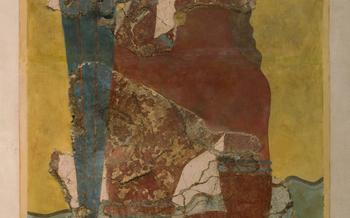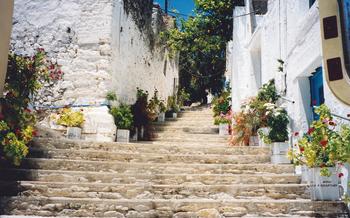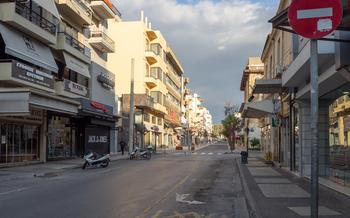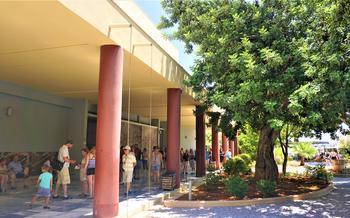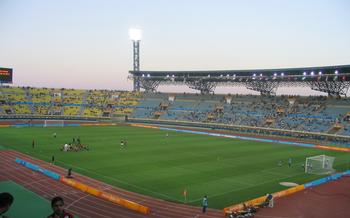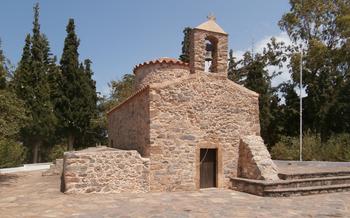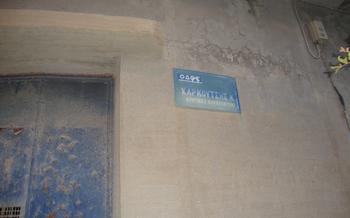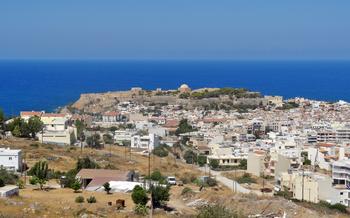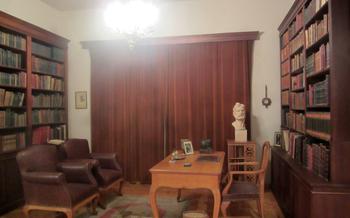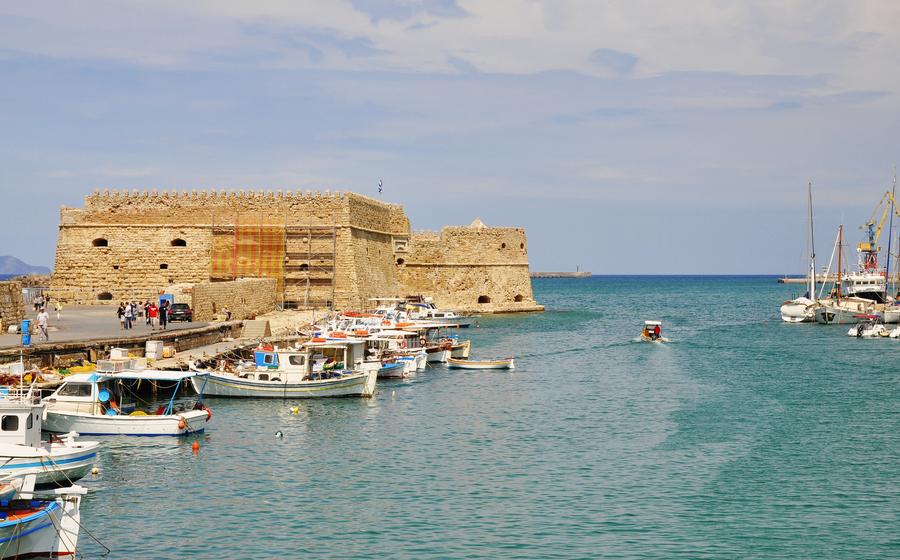
Vathypetro Minoan Estate
- Vathypetro Minoan Estate: A Journey Through Time
- Location and Accessibility
- The Grand Manor: Seat of Minoan Power
- Unveiling the Secrets of the Royal Tombs
- The Olive Press: A Testament to Minoan Ingenuity
- Unlocking the Mysteries of the Workshops
- Immerse Yourself in Minoan Culture at the Museum
- Strolling Through the Picturesque Village
- Indulge in Authentic Cretan Cuisine
- Minotaur Myth and Connection to Knossos
- Seasonal Events and Festivals
- Photography Opportunities: Capture the Essence of Crete
- Sustainable Tourism Practices: Preserving the Legacy
- Insider Tip: Uncrowded Hours and Local Insights
Vathypetro Minoan Estate: A Journey Through Time
The Vathypetro Minoan Estate stands as a testament to the splendor and ingenuity of the ancient Minoan civilization. This well-preserved estate offers a glimpse into the past, transporting visitors back to a time when Crete was a maritime empire that ruled the Mediterranean Sea. As you step through the gates of the estate, you will be captivated by the unique features that set the Minoan civilization apart, from their advanced architecture to their sophisticated system of writing. Archaeological discoveries at Vathypetro, including intricate frescoes, ceramic vessels, and tools, provide valuable insights into the daily life, beliefs, and practices of this remarkable civilization. Preserving and protecting this cultural heritage is of utmost importance, as it allows us to connect with our roots and gain a deeper understanding of the foundations of Western civilization.
Location and Accessibility
The Vathypetro Minoan Estate is situated approximately 15 kilometers southeast of Heraklion, the capital city of Crete. It is conveniently accessible by car, with well-maintained roads leading to the estate. Alternatively, visitors can opt for a scenic bus ride from Heraklion, enjoying the picturesque countryside along the way. The estate is also situated in close proximity to other notable attractions in Heraklion, such as the Palace of Knossos, the Heraklion Archaeological Museum, and the Venetian Fortress. Guided tours are available for those who prefer a more structured and informative experience, offering insights into the history and significance of the estate.
The Grand Manor: Seat of Minoan Power
At the heart of the Vathypetro Minoan Estate lies the grand manor, an architectural masterpiece that once served as the center of power and administration during the Minoan era. Its imposing structure, adorned with intricate stonework and elegant columns, reflects the grandeur and sophistication of Minoan civilization.
Inside the manor, visitors can explore a labyrinth of interconnected rooms and corridors, each serving a specific purpose. The throne room, with its elevated platform and elaborate frescoes, speaks to the authority of the Minoan rulers. The storage rooms, filled with amphorae and other artifacts, provide a glimpse into the estate's economic activities. And the private chambers, with their finely crafted furniture and artwork, offer a glimpse into the lives of the Minoan elite.
Excavations at the manor have unearthed a wealth of artifacts, including pottery, tools, weapons, and jewelry. These discoveries have shed light on the daily lives, customs, and beliefs of the Minoans. Among the most notable finds are the exquisite frescoes adorning the walls of the manor, depicting scenes of religious rituals, hunting expeditions, and everyday life. These vibrant and lifelike paintings offer a unique window into the artistic and cultural achievements of this ancient civilization.
Unveiling the Secrets of the Royal Tombs
Deep within the grounds of Vathypetro Minoan Estate, a cluster of ancient tombs lies concealed, inviting visitors to delve into the mysteries of Minoan burial practices. These subterranean chambers, meticulously carved into the bedrock, served as the final resting places for prominent figures of the Minoan civilization.
The tombs, varied in size and complexity, offer a glimpse into the social hierarchy and religious beliefs of the Minoans. Elaborate stone facades adorned with intricate carvings and symbolic motifs hint at the importance of the individuals interred within.
Inside the tombs, archaeologists have uncovered a wealth of artifacts, including intricately crafted pottery, bronze vessels, jewelry, and weapons. These precious objects, often buried alongside the deceased, provide insights into the material culture and artistic prowess of the Minoans.
The most notable among the royal tombs is the "Tholos Tomb," a circular structure with a corbelled roof, reminiscent of the famous beehive tombs found elsewhere in Crete. This impressive tomb, with its spacious interior and elaborate construction, is believed to have belonged to a high-ranking Minoan ruler or dignitary.
Excavations have revealed that the Minoans practiced elaborate burial rituals, often involving the placement of food, drink, and personal belongings in the tombs to accompany the deceased on their journey to the afterlife. These offerings, along with the architectural features and artifacts found within the tombs, shed light on the Minoan's complex beliefs and customs surrounding death and the hereafter.
The Olive Press: A Testament to Minoan Ingenuity
Olive cultivation played a pivotal role in Minoan Crete, with the Vathypetro Minoan Estate showcasing an impressive olive press, a testament to the Minoans' agricultural prowess. This well-preserved press provides valuable insights into their sophisticated understanding of olive oil production.
The olive press, consisting of a large stone basin and a press mechanism, exemplifies the Minoans' ingenuity. Olives were crushed using a heavy stone roller, and the resulting paste was placed in woven baskets or bags. These baskets were then stacked atop one another, and a large stone weight was placed on top to extract the precious oil.
Olive oil was not just a culinary staple for the Minoans; it held economic and cultural significance as well. It was used for cooking, illumination, religious rituals, and even as a form of currency. The olive tree, revered as a sacred symbol, was often depicted in Minoan art and iconography.
Excavations at the estate have revealed an extensive network of olive groves, further emphasizing the importance of olive cultivation in Minoan society. These groves, along with the well-preserved olive press, offer a glimpse into the agricultural practices and economic activities of this ancient civilization.
Unlocking the Mysteries of the Workshops
Among the intriguing features of the Vathypetro Minoan Estate are the numerous workshops scattered throughout the site. These workshops provide a glimpse into the diverse crafts and industries practiced by the Minoans. Each workshop is unique, showcasing a specific skill or trade that was essential to the functioning of Minoan society.
Pottery Workshop: In this workshop, skilled artisans fashioned clay into a variety of vessels, from utilitarian pots and jars to ornate vases and figurines. Visitors can observe the techniques used by Minoan potters, including hand-building, wheel-throwing, and firing in traditional kilns.
Textile Workshop: The Minoans were renowned for their intricate textiles, woven from wool, linen, and silk. In the textile workshop, visitors can learn about the processes of spinning, dyeing, and weaving, and admire the beautifully preserved fabrics that have been unearthed at the site.
Metalworking Workshop: Metalworking was another important industry in Minoan Crete. In this workshop, craftsmen used bronze and other metals to create tools, weapons, jewelry, and decorative objects. Visitors can marvel at the skill and precision with which the Minoans worked with metal, using techniques such as casting, forging, and engraving.
Stoneworking Workshop: The Minoans were adept at working with stone, as evidenced by the impressive stone structures and artifacts found at Vathypetro. In the stoneworking workshop, visitors can see how the Minoans quarried, shaped, and carved stone to create buildings, tools, and sculptures.
Woodworking Workshop: Woodworking was another essential craft in Minoan society. In this workshop, artisans fashioned wood into furniture, tools, and other objects using simple tools and techniques. Visitors can learn about the types of wood used by the Minoans and the techniques they employed to create functional and decorative items.
These workshops offer visitors a fascinating glimpse into the daily lives and skills of the Minoans. By exploring these spaces, visitors can gain a deeper understanding of the ingenuity and creativity of this ancient civilization.
Immerse Yourself in Minoan Culture at the Museum
Nestled within the Vathypetro Minoan Estate, the on-site museum serves as a treasure trove of artifacts and exhibits that provide a captivating glimpse into Minoan life and culture. As you step through its doors, you'll be transported back in time, surrounded by remnants of a civilization that flourished over 4,000 years ago.
The museum showcases an array of artifacts unearthed during excavations at the estate, including pottery, tools, jewelry, and religious objects. These artifacts offer insights into the daily lives, customs, and beliefs of the Minoans. Interactive displays and educational resources bring the exhibits to life, allowing visitors to engage with the material and gain a deeper understanding of Minoan culture.
Guided tours or audio guides are available to enhance your museum experience. Knowledgeable guides will lead you through the exhibits, providing expert insights and historical context. Alternatively, you can opt for a self-guided tour, using the audio guides to learn about the artifacts at your own pace.
Whether you choose a guided or self-guided tour, the Vathypetro Minoan Estate Museum promises an immersive and educational journey into the fascinating world of the Minoans. It's an opportunity to connect with the past and gain a deeper appreciation for the rich cultural heritage of Crete.
Strolling Through the Picturesque Village
Beyond the archaeological wonders of the Vathypetro Minoan Estate lies a charming village that exudes traditional Cretan character. As you wander through its narrow cobblestone streets, you'll be greeted by whitewashed houses adorned with colorful flowers and intricate architectural details. The village square, with its shady trees and lively tavernas, serves as a gathering place for locals and visitors alike.
Here, you can browse local crafts and souvenirs at the quaint shops, or savor the flavors of traditional Cretan cuisine at one of the many tavernas. Indulge in mouthwatering dishes prepared with fresh, local ingredients, and don't miss the opportunity to sample the region's renowned olive oil, a legacy of the Minoan civilization.
Interacting with the local community is a rewarding experience. Engage in friendly conversations with the villagers, who are always eager to share their stories and traditions. Participate in village festivals and events, where you can witness traditional Cretan music, dance, and theater performances. Immerse yourself in the vibrant culture and warm hospitality that define this charming village.
Indulge in Authentic Cretan Cuisine
As you explore the Vathypetro Minoan Estate, take a break to savor the delicious flavors of traditional Cretan cuisine. The village boasts a selection of tavernas and restaurants that serve mouthwatering dishes, using fresh, locally sourced ingredients.
Must-try Cretan delicacies include dakos, a barley rusk topped with chopped tomatoes, feta cheese, and olive oil; gamopilafo, a wedding pilaf with lamb or goat meat; and kalitsounia, savory pastries filled with cheese, herbs, or minced meat.
Food played a vital role in Minoan culture, and the island's culinary traditions have remained largely unchanged over the centuries. Olive oil, a staple of the Minoan diet, is still widely used in Cretan cooking, adding a unique flavor to dishes.
Indulging in authentic Cretan cuisine is not just a culinary experience but also a journey into the heart of Minoan culture. Take the opportunity to visit local markets, interact with farmers and vendors, and learn about the traditional methods of producing Cretan delicacies.
Cooking classes or workshops are also available, allowing you to immerse yourself in the culinary traditions of Crete and learn to prepare some of the island's most beloved dishes.
Whether you're enjoying a leisurely lunch at a village taverna or savoring local delicacies at a cooking class, the flavors of Crete will linger in your memory long after your visit to the Vathypetro Minoan Estate.
Minotaur Myth and Connection to Knossos
Beyond its archaeological significance, Vathypetro Minoan Estate is deeply intertwined with the captivating myth of the Minotaur and its connection to the legendary Palace of Knossos. According to Greek mythology, the Minotaur, a fearsome creature with the head of a bull and the body of a man, was imprisoned in the intricate labyrinth beneath the palace of King Minos.
Archaeological evidence unearthed at the Vathypetro estate and the Palace of Knossos suggests a compelling link between the two sites. The discovery of bull horns and other Minoan artifacts at the estate hints at a shared cultural and religious significance. Furthermore, the proximity of Vathypetro to Knossos, situated just a short distance away, adds weight to the theory that the two locations were closely interconnected.
The myth of the Minotaur has captivated imaginations for centuries, inspiring artistic representations, literary works, and even modern-day interpretations. Visiting Vathypetro Minoan Estate offers a unique opportunity to explore the tangible remnants of this ancient legend, providing a glimpse into the rich mythology that has shaped the history and culture of Crete.
Seasonal Events and Festivals
Throughout the year, the Vathypetro Minoan Estate comes alive with a variety of cultural events, festivals, and performances that celebrate the rich heritage and traditions of Crete. These events offer visitors a unique opportunity to immerse themselves in the vibrant culture of the island and experience the warmth and hospitality of the local community.
Traditional Cretan music, dance, and theater take center stage at these festivities, showcasing the island's rich artistic heritage. Visitors can witness skilled musicians playing the haunting sounds of the lyra, the rhythmic beats of the laouto, and the soulful melodies of the mandolin. Cretan dancers, adorned in colorful costumes, perform intricate steps and graceful movements that have been passed down through generations.
These events also provide a platform for local artisans and craftsmen to showcase their skills and products. Visitors can browse stalls selling handmade pottery, woven textiles, intricate jewelry, and other traditional crafts. Local delicacies and culinary delights, such as freshly baked bread, aromatic cheeses, and succulent grilled meats, are also on offer, tantalizing the taste buds and offering a taste of authentic Cretan cuisine.
By attending these seasonal events and festivals, visitors can gain a deeper understanding of the vibrant culture and traditions of Crete, while creating lasting memories of their time spent at the Vathypetro Minoan Estate. Be sure to check the event calendar before your visit to plan your trip accordingly and make the most of these special occasions.
Photography Opportunities: Capture the Essence of Crete
Vathypetro Minoan Estate offers a treasure trove of photographic opportunities, allowing visitors to capture the essence of Crete's rich history and natural beauty. From the majestic ruins of the Minoan settlement to the picturesque village nestled amidst olive groves, every corner of the estate is waiting to be immortalized through the lens of a camera.
For those seeking to capture the grandeur of the Minoan civilization, the estate's ancient structures, such as the grand manor and the royal tombs, provide a perfect backdrop. The intricate details of the architecture, the weathered stones, and the surrounding landscape combine to create a sense of timelessness that is sure to captivate any photographer.
The village, with its traditional whitewashed houses, narrow cobblestone streets, and vibrant bougainvillea flowers, offers a glimpse into the authentic Cretan way of life. Capturing the daily routines of the locals, the bustling markets, and the traditional festivals can provide a unique and personal perspective on the island's culture.
To make the most of your photography experience, consider arriving early in the morning or late in the afternoon, when the soft, golden light casts a magical glow on the surroundings. Experiment with different angles and perspectives to create dynamic compositions that showcase the estate's unique features.
For aspiring photographers seeking to elevate their skills, workshops or exhibitions held at the estate offer an opportunity to learn from experts and gain insights into capturing the essence of Crete. These events provide a platform for sharing techniques, discussing composition, and showcasing the work of talented photographers.
Sustainable Tourism Practices: Preserving the Legacy
Vathypetro Minoan Estate is committed to responsible tourism, ensuring that its unique cultural heritage is preserved while visitors enjoy an enriching experience. Guided tours prioritize conservation, minimizing environmental impact and educating visitors about the importance of protecting the site. Eco-friendly practices, such as recycling and waste management, are implemented to reduce the estate's footprint. Supporting local businesses and initiatives helps sustain the community and preserve traditional ways of life. Through responsible tourism, visitors can contribute to the longevity of this remarkable estate and its invaluable legacy for future generations.
Insider Tip: Uncrowded Hours and Local Insights
To fully immerse yourself in the tranquility of the Vathypetro Minoan Estate, plan your visit for the early morning or late afternoon hours, when the crowds are typically smaller. This will allow you to wander through the ruins at your own pace, soak in the serene atmosphere, and capture stunning photographs without distractions.
Engage with the local guides or residents to gain insider knowledge about the estate and its history. They can share captivating stories, point out hidden gems, and provide a deeper understanding of the Minoan civilization. Ask about local customs, traditions, and culinary delights to enrich your experience.
Venture off the beaten track to discover lesser-known areas of the estate. Explore the picturesque surroundings, admire the panoramic views, and uncover hidden corners that offer unique perspectives. Embrace the seasonal variations of Crete; each season brings its own charm, from the vibrant spring wildflowers to the golden hues of autumn. Plan your visit accordingly to witness the island's natural beauty at its peak.
